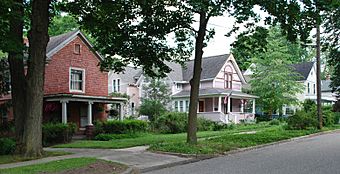Old West Side Historic District facts for kids
Quick facts for kids |
|
|
Old West Side Historic District
|
|
 |
|
| Location | Bounded roughly by 7th, Main, and Huron Sts., Pauline Blvd., and Crest Ave., Ann Arbor, Michigan |
|---|---|
| Area | 250 acres (100 ha) |
| Architect | John Lucas, John Koch |
| Architectural style | Colonial Revival, Bungalow/craftsman, Gable-front 19th-early 20th-century |
| NRHP reference No. | 72000661 |
| Added to NRHP | April 14, 1972 |
The Old West Side Historic District is a special neighborhood in Ann Arbor, Michigan. It's known for its beautiful old homes and tree-lined streets. This historic area is roughly bordered by 7th Street, Main Street, Huron Street, Pauline Boulevard, and Crest Avenue.
The district was added to the National Register of Historic Places in 1972. This means it's officially recognized as an important place in history. The Old West Side shows what many neighborhoods in the Midwest looked like in the 1800s. In 1967, people who lived there formed a group called the Old West Side Association. They wanted to help protect and preserve their unique neighborhood.
Contents
What Makes the Old West Side Special?
The Old West Side is mostly filled with small, single-family homes. These houses are usually two stories tall and have six or seven rooms. Most of them are made of wood and covered with clapboard siding. You can also find houses with shingled or stuccoed walls. About 15% of the homes are made of brick.
Many houses in the neighborhood have a front-gabled roof. This means the roof slopes down on the front and back, with a triangular shape facing the street. Lots of homes also have a wide front porch with pillars. The bigger houses, especially along West Liberty, often have more detailed designs and fancy decorations.
Architectural Styles You Can See
The Old West Side shows off many different building styles from 1860 to 1914. You can see homes built in the Italian villa style. There are also Queen Anne houses, which are known for their fancy details.
Other styles include classic revival homes and simpler New England or colonial revival designs. You might also spot Gothic cottages or larger Colonial and Georgian revival mansions. Some houses are a mix of different styles, making each one unique!
A Look at the Neighborhood's History
The history of the Old West Side began in 1845. A man named William Maynard bought a large piece of land west of Ann Arbor. He started dividing this land into smaller lots for people to build homes. Most of what is now the historic district was part of Maynard's property.
Growth and Change Over Time
Many German immigrants who had settled near Ann Arbor were attracted to this new area. After the American Civil War, the local economy grew quickly. New industries started, bringing in many workers. A lot of these workers bought lots and built homes in Maynard's new neighborhood. Houses continued to be built here until World War I.
Protecting the Historic Charm
After World War II, some parts of the Old West Side started to change. Many of the houses were getting old. Some residents moved to newer homes in other areas. Larger homes were sometimes divided into apartments, and a few were even torn down to make way for new apartment buildings.
To help save the neighborhood's historic feel, the Old West Side Association was created in 1967. This group worked to protect the old homes and keep the area special. In the years that followed, many new families moved into the neighborhood. They helped bring new life while still valuing its history.
Images for kids




